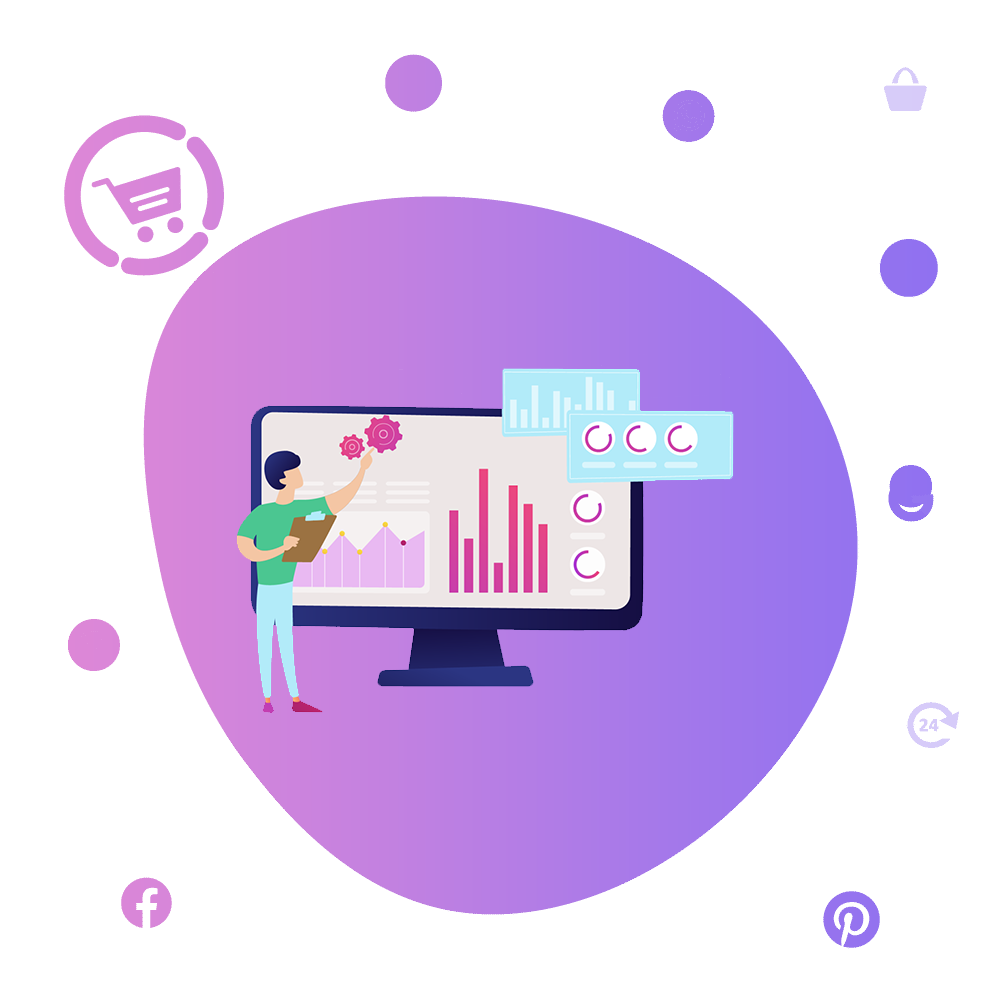
How to sell on Facebook for small businesses in South Africa
October 23, 2023
How to sell on Facebook marketplace for beginners 2024/25
October 27, 2023If you’ve ever considered starting an eCommerce business or taking your existing store digital, there’s no better time than now.
As everything from education to entertainment has made its way to the digital landscape, retail remains at the forefront. Global juggernauts like Amazon and eBay and more eclectic big-wigs like Etsy have redefined what it means to sell online.
The question then is, where do you actually start an eCommerce business? And if you’ve already started, how do you grow your fledgling store into a toe-to-toe competitor? As daunting as the idea of setting up shop, or as daring as it is to consider scaling your business into new territories, it all begins with the proper planning.
So, let’s break down everything you need to know about eCommerce business planning and how you can shape your store.
Quick tip: Get in touch with Netcash Shop’s experts to help you get started with your eCommerce business planning.
What is a business plan, and why is it so important?
A business plan describes your business and contains all the essential information about your business, such as:
- Description of your products and services
- Your eCommerce business model
- The leadership, management, and staffing structure
- Your financial plan and growth strategy
- A marketing plan
- The business mission statement
- Brand values
Why does all of that need to be in one document? One of the most crucial reasons you need a well-crafted business plan is when you need financing from 3rd parties or specialised permits from governmental agencies.
If you are in a position where you do not need external funding or permits, you’ll use your business plan as a guiding model for future scaling and planning. Beyond that, you can use it to evaluate your business and determine growth areas.
Quick tip: Already have the foundations of your business planning laid out? Check out our how-to guide on setting up your eCommerce business plan.
Setting up the ultimate eCommerce business plan
Here’s our full breakdown of every critical element that should be in your eCommerce business plan.
Executive summary
Ironically, the executive summary, the first part of a business plan, is often written right at the end. Within this page, you’ll outline everything that is included in the rest of your business plan, making it one of (if not the) most crucial sections.
Use your executive summary to explain the type of eCommerce business you’re operating and indicate the current status, for example, whether you’re starting out or would like to expand.
When writing your executive summary, keep it aligned with your ultimate business goals and include information showing that you’ve done your research. Highlight important aspects such as sales forecasts and the main details of your brand.
Your typical eCommerce business plan can be broken down into subsections, including the following:
- Business opportunity – Give a foresight of how you plan to capitalise on your venture.
- Market projections – Detail your intended customer base.
- Business structure – Provide information about your overall business structure.
- Market analysis – Briefly overview your market research and sales strategy.
- Financial analysis – Short overview of your financials and projections.
- Organisational structure – Give concise information about management and staff.
Keep in mind:
- Your executive summary isn’t a complete repeat of the entire business plan.
- Use it to summarise your vision for the business.
- Outline your products and provide brief descriptions.
- Include a short description of your target market.
- Highlight your management team.
- Include a brief section on your financials and marketing plan.
Business overview
In this section, you’ll dive into the various features of your venture, but while the previous part of your plan focused on qualitative information, your overview is more cut and dry.
Include the following within your business overview:
Brand name
Beyond just stating your brand name, provide some background info and use it to set the tone for the rest of the business plan. Explain why you chose your name and what it means for your business.
Business type
Don’t confuse this with your business model. Here, you will describe or label your business according to South African legal prerequisites. These include:
- Sole proprietorship – This refers to businesses with a single founder who owns and runs the business.
- Partnership – This is a business run by two or more co-owners who pool their resources and skills toward a common goal.
- Proprietary limited company (Pty Ltd) – This is a private company treated as a legal entity, and the owners are considered shareholders.
- Public company – This business issues securities and trades stock in the business on at least one stock exchange.
- Franchise – This is where a business owner licences the business to third parties.
Domain name
Remember that you’re in the eCommerce world now, so your domain name needs to be enticing to buyers but also fit modern SEO (Search Engine Optimisation) needs.
Quick tip: Find out everything there is to know about a small business SEO strategy with our handy guide.
Value proposition
This is a crisp, short, and clean statement that gauges how clear your business idea is. Think of it as a one-minute description that explains to a potential investor or customer why they should choose you above the competition.
It can also double as your company description on your eCommerce storefront. Consider using the right amount of sensory words in this.
Mission & Vision
Two of the most highly-valued aspects of any business are its mission statement and vision.
Your mission statement is the “why” of your business. Explain what made you start your business in the first place. Your vision is the “how” in the grand scheme of your business design.
Go into depth on the ultimate dream or goal you have with your business while illustrating the way you intend to achieve it. The vision of your business is long-term, so consider where you want your business to be in 5, 10, or 20 years from now.
There are avenues available to you if you hit a snag when plotting out your business’ future, such as The Yellow Door Collective.
Brand traits
This is a short but compelling section to showcase the main characteristics of your business in as few words as possible. List at least three to five words that impactfully describe your business and its unique personality.

Quick tip: Here’s our how-to guide to creating the perfect eCommerce business plan.
Business analysis
Your business analysis is where you’ll aim to cover the logical aspects of your business in precise detail.
Think about elements that someone without any knowledge of your business would have questions about. Go into the nitty-gritty about what your company does, explain why it’s unique, and tell the reader how your business has an advantage over the competition.
You’ll also have the chance to provide specific details that can make or break the overall impact of the section. Two of these are:
Illustrating your business model
A business model defines how your business will make money. It dictates how you go about sourcing and creating your products, how you offer them to the market, and how you drive sales and increase revenue.
Use this section of your business analysis to clearly define which business model you plan to use or are already using.
You may fall into a model based on customers, such as:
- Business-to-consumer (B2C) – Selling directly to your end-user.
- Business-to-business (B2B) – Directing sales at another business.
- Consumer-to-consumer (C2C) – Providing a platform for consumers to sell to other consumers.
- Consumer-to-business (C2B) – Providing a platform where consumers sell to businesses.
- Business-to-government/administration (B2A) – Selling products to governmental or administrative agencies.
- Consumer-to-government/administration (C2A) – Providing a platform where consumers sell to governmental or administrative agencies.
Alternatively, your business model might be based on businesses such as:
- Drop Shipping – Your company sells products, and a supplier fulfils the orders.
- Wholesaling and warehousing – You sell your products and complete the order yourself.
- Private labelling and manufacturing – Your business sells and manufactures unique products, or you outsource the manufacturing.
- White labelling – Similar to private labelling, but instead, your product is not unique, and the manufacturer creates it under other brand names.
- Subscription – Selling a product or service on a subscription basis, where customers pay per week/month/year.
Defining your product and industry
Here, you have the opportunity to give more information about your products. Aside from setting out your niche, you can address your unique selling point (USP) and what sets you apart from other eCommerce retailers.
It’s also a good move to lay out how you plan to compete with market leaders in the industry. Finally, the two most important topics to cover here are the customer-focused problem your product or service aims to solve and what needs you’ll fulfil.
Market/Industry Analysis
Your market or industry analysis focuses on the overarching eCommerce landscape you’re entering or already a part of. This section of your business plan serves many purposes.
The first is that while researching the eCommerce industry, you educate yourself, which helps you understand the market you plan to operate in.
Secondly, market or industry analysis enables you to improve your overall strategy, particularly when looking for possible market trends that you can take advantage of.
And finally, when you compile your analysis and research and present it in your eCommerce business plan, you showcase your expertise. You achieve this by offering answers to the following questions (backed by research, of course):
- How big is the eCommerce field (in monetary value) you are entering?
- Is the current market you’re entering increasing or declining?
- Who are your key competitors?
- Who are the key suppliers to the market?
- What trends currently affect and potentially affect the industry in the future?
- What is the projected industry growth forecast?
Target market analysis
A critical part of your overall market or industry analysis is determining and outlining your target market — also known as your target audience or persona — which is most often the sole focus of eCommerce business strategies.
Many foundational pieces of your business rely on who you identify to be your target audience. These include elements of your marketing strategy, creating your eCommerce website, and your advertising needs.
The first objective of this section is to gather market segments and consumer profiles. You’re breaking down your target audience into demographics and psychographics.
Demographic data is what you’ll use to establish the appropriate marketing channels you’ll use down the line. Take into consideration segmenting your target audience based on the following:
- Age
- Race
- Gender
- Education
- Employment status
- Occupation
- Income
- Relationship status
- Location
Psychographic data gives insights into your potential customer’s personalities, attitudes, interests, and values. These attributes guide their purchasing decisions and include the following:
- Activities
- Interests
- Hobbies
- Opinions
- Values
- Attitudes
- Behaviours
- Political affiliations
- Lifestyle preferences
Estimated market size
Here, you can inform your team and potential or existing investors about the monetary value of your business. Use this section to address the following:
- Total addressable market (TAM) – This is where you can present the maximum available revenue of your business. Think of it as representing how much income you could earn if every person in your target market becomes a buying customer.
- Penetration rate – This is an estimated percentage of potential customers you aim to acquire relative to the total size of your target market. Using this, your team and investors can quantify the overall business opportunity.
- Competitor details – Use this to give more information about existing competitors, illustrating their pros and cons and demonstrating how your business and products differ. You can also use this to detail how you intend to take some of your competitor’s market share further down the line.

Competitor analysis
Within this part, you can list the market leaders and your direct and indirect competitors.
Provide a short overview of the market leaders, who they are, what sets them apart, and other relevant details. Then, flow into your direct and indirect competitors.
Direct competitors
These are other eCommerce businesses precisely in line with your niche and target audience. Identify those offering similar products or services, then do a deep dive for each by measuring each according to a SWOT (strengths, weaknesses, opportunities, threats) analysis.
Conducting a SWOT analysis will answer some questions, including:
- What types of customers do they target and serve?
- What products form part of their offering?
- What is their pricing like?
- What are they good at, and how do they execute their strengths?
- What are their weaknesses, and how do they overcome them?
Indirect competitors
Indirect competitors represent alternative options that customers have to purchase from.
Think of them as offline retailers (brick-and-mortar businesses) or other eCommerce businesses that sell products or services that meet the exact needs as those you offer. It’s essential to highlight that you, as a business owner, know that not everyone who needs your product will frequently buy it from you.
Competitive analysis
The next part of your competitor analysis is where you highlight your areas of competitive advantage. Here, you should provide concrete answers to the following:
- Will you provide superior eCommerce services, and how?
- Will you offer certain eCommerce products or services that your competitors do not?
- How will you make it more convenient for customers to get a product?
- Do you provide superior customer support services?
- Is your pricing better than your competitors?
Business structure
This is a very short descriptive section where you outline the key personnel in your company. Highlight the founder and the executive team, with some info for each (although not always needed).
Outline the legal structure of your business, introduce your leadership team, and then provide an organisational chart. Key roles (if your team has them) to highlight here include:
- Company owner
- Chief Executive Officer
- Partners
- Management team
- Customer services manager
- Logistics manager
- Public relations and social media specialist
- Advertising manager
- SEO manager
- Copywriters
Products and services
After you’ve covered your business structure, the next section tackles the product options and variations you’ll offer your customers and how they can access them. Begin this section by listing your products and including detailed product descriptions and pricing information.
You’ll have to answer the following questions:
- If you’re offering digital products, will your customers have to stream or download the content?
- Will you be charging a subscription fee to access your content platform, or will customers have to pay for each content piece?
- If you provide a specific service, will you do it at physical premises or travel to customers’ houses?
- Will you sell your products in a physical store, online, or both?
Then, discuss and detail your positioning and profit margins. Finish off this part of your eCommerce business planning by diving into the logistics and manufacturing of your products.
Logistics and manufacturing
eCommerce and logistics go hand-in-hand, and the effort you put into figuring out every detail about the logistical and manufacturing side of things will pay off in the long run. Some considerations to include here are:
- Location – While your business might be online, when it comes to your products, you’ll need to think about warehouse or office space for employees. Include details about where these locations will be and estimated running costs.
- Suppliers – Describe your suppliers for the raw materials you’ll use to manufacture your products in-house, as well as packaging details. If you’re reselling products, this is where you can give details about the suppliers you’ll use to do so.
- Storage and fulfilment – Unless you’re dropshipping your products to your customers, you must store and ship your items. In this section, describe where and how storage and order fulfilment will happen. Detail your estimated costs and remember things like returns, exchanges, and abandoned carts.
- Technology and payment gateways – At the basis of every eCommerce business is the tech it uses. Especially when it comes to buying, shipping, and selling your products, detail what platform you’ll use to run your site. Keep in mind that some platforms like Netcash Shop offer “headless eCommerce”, meaning you can sell from anywhere with or without a store. Another crucial aspect of this point is your payment gateways.
Marketing plan
It can’t be overstated that marketing is everything, which makes this a critical part of your overall eCommerce business planning.
Here, you’ll include information about the advertising strategy you intend to use and how it will set you apart from the competition. This is also the perfect place to give details about your plans for lead generation and the channels you’ll use to reach your target audience.
These are some key points to highlight in your marketing plan:
- Content marketing – One part of your marketing strategy should focus on adding blog posts to your online eCommerce store that potential customers could find exciting and guide their buying decisions.
- Social media – Can you make money on social media? Yes. Most customers these days expect their favourite retailer to have a social media presence. Decide on which social media platforms your business will target and develop a social media strategy to detail how.
- Advertising – In the eCommerce landscape, most (if not all) of your advertising will be online, which enables you to access valuable metrics such as reach and effectiveness.
- Email marketing – When operating your eCommerce store, email marketing helps you drive revenue and increase sales. This can also tie into your overall content marketing plan when you offer select deals, such as free shipping with each email sign-up.
The above are considered organic marketing channels, but you can also opt for paid marketing tactics, such as:
- Pay-per-click – When working with this model, you’ll mostly work with Google’s Shopping campaigns or Google Ads, where you pay a certain amount, and your ads get displayed to your target audience.
- Affiliate sales networks – When you work with another blog or website that sells or promotes your product on your behalf, you’re using affiliate marketing. The third-party site or blog gets paid a commission on every successful conversion.
- Facebook Ads – Depending on your budget, you can target ads on Facebook toward your intended audience, potentially driving traffic to your store.
- Influencer marketing – This is where you pay an industry influencer to promote your store or products on their social media channels to get the word out.
Financial plan
As a startup, your financial analysis is critical to determine your initial costs, especially when approaching potential investors.
If you’re already up and running, you can use your financial plan to estimate how long it will take your business to make money. This is where you can highlight information about projected ROI (return on investment) for current investors.
An essential part of your financial plan is your income statement (or a Profit and loss statement), which you’ll use to illustrate financial projections.
Income statement
Within your income statement, you’ll forecast sales, expenses, and estimated net income. There are three key points to touch on when setting up your income statement:
- Projected revenue – Here, you estimate the total number of units sold and then, based on that, give a projected revenue. Use this simple formula to help:
Projected revenue = Number of units sold multiplied by average sales price
- Fixed expenses – Detail those expenses that will remain constant regardless of how much you sell. Typically, these are your SaaS subscriptions, employee salaries, or rent.
- Variable expenses – Your variable expenses change continuously in direct proportion to how much you sell.
While determining the true cost of running an eCommerce business is challenging, half the battle is already won when you have a carefully planned financial plan. Your main aim with this part of your business plan for eCommerce is to provide answers to these questions:
- How much will you need to sell to meet your income goals?
- What are your profit margins on your different products?
- What is the estimated lifetime value of a customer?
- How much can you spend on customer acquisition?
- Are there any major investments you need external funding for?
- What are the possible improvements to your gross margins?
Wrapping up your eCommerce business planning
While getting started with a solid eCommerce business plan can set you up for success, having one to fall back on along your journey is crucial. With this full rundown, you can rest assured, knowing that once you’ve put pen to paper and have ticked all the boxes, your business plan will do the rest.
Before you go: Contact Netcash Shop today to find out how our team of eCommerce experts can fast-track your business plan and help get you going.
Candice Sergeant is an experienced eCommerce Product Owner at Netcash, driving the growth strategy for SaaS e-commerce solutions in South Africa with global partner Ecwid by Lightspeed. Candice is skilled at uncovering opportunities to optimize the online presence and operations of startups and medium businesses across a range of industries.

Subscribe to our mailing list to learn about our new features and marketing tips & tricks.











